Please complete this simple three-question survey about staircases and handrails.
You'll be contributing to the intergalactic collection of combined knowledge.
Please complete this simple three-question survey about staircases and handrails.
You'll be contributing to the intergalactic collection of combined knowledge.
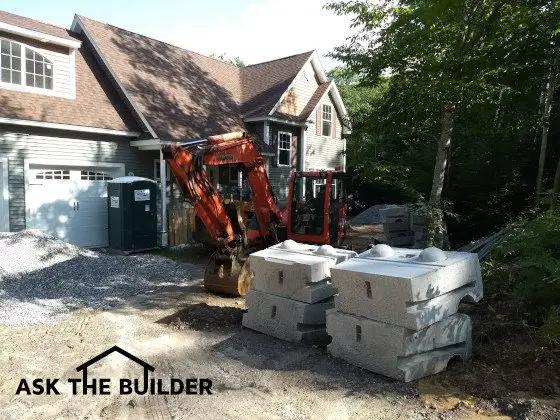
The woman who used to own this uncompleted new house didn’t do her due diligence. A contractor now owns it and is trying to finish it two years after the foundation hole was dug! (C) Copyright 2018 Tim Carter
This column was inspired by something that happened to my sister last week. She called me for advice because she needed a tree removed from her rear yard and she didn’t know any reliable tree-removal companies.
Perhaps you’ve been in the same situation recently about any number of repairs or projects that you need to be done at your own home. My sister subscribes to my newsletter and she knows that I promote one of the national contractor referral networks. It’s called HomeAdvisor and they claim to connect homeowners like my sister and you with pre-screened, local service professionals.
What follows is all true and much of it you probably don’t want to hear. Based on the number of emails I receive each week, I see a growing and alarming trend of people who are so busy, so stressed, and so discombobulated that all they want is the easy button. They want the mythical magic home improvement fairy to float down out of the sky and place the best contractor in their driveway. That’s a fantasy.
Here’s what happened to my sister and it’s possibly happened to you. She filled out the form at my website to get quotes from the prescreened tree removal companies in Cincinnati, OH. Guess what? There was only one in the network or at least only one that responded.
The company that responded to my sister’s request sent an employee that could only speak a few words of English, the only language my sister speaks. She told me, “He stood 15 feet away from the front door and just kept saying the word ‘tree’.”
Frustrated, my sister closed the door on him and I imagine he drove away. So much for prescreening professionals.
What’s the answer? What are you to do when you need a pro to fix something for you?
Here are some facts to help you find the pros. In almost all cities and towns, there are craftsmen and craftswomen who do have integrity and who take pride in their work. It may be a small number, but they exist.
In most cities and towns, there are a small group of tradespeople that do things the right way and know to buy the best products because failed products on jobs make profits disappear faster than a coin from a close-up magician’s hands.
The best contractors and sub-contractors usually don’t advertise nor do they belong to the contractor networks like HomeAdvisor and Angie’s List. They don’t have to. They get booked out months in advance just from word-of-mouth promotion from their past satisfied customers. This is an often overlooked fact.
The best contractors typically purchase the best products and materials from local businesses, not giant national brands. The best products and materials are not always at the giant home center big box stores. It’s amazing how a multi-million dollar advertising budget can make you think otherwise!
You’ll often find the best products and materials at the traditional lumberyards that still exist in most larger cities and towns. You may also find some at the old-fashioned hardware stores in your neighborhood.
The best contractors use the best products because they don’t want to have to come back and fix something. They don’t want you upset. They want to be working on the next job, not be back at your house redoing work.
Weeks and months before you need the work done, you need to start to find the great contractors. Why? The great contractors have a backlog of work!
You get the list of these great workers when you talk with the general manager of the local lumberyards or the owners or managers of the local hardware stores. You ask them bluntly, “Please be kind enough to share with me the names of the three best contractors that come in here that you would have work on your home.”
In the old days, my sister would have just opened the Yellow Pages or looked in the newspaper classified ads for the names of tree removal companies. Those were the reliable search engines before the Internet.
I instructed her to just type into the current online search engines: tree removal cincinnati to get a list of the companies that cut down tall sick white pine trees. She’s currently getting quotes and making sure they all have current general liability insurance and are in good standing with the State of Ohio Workmen’s Compensation program.
There is no easy button. You need to do the hard work ahead of time if you want to get the best workers in exchange for your hard-earned money. I’m sorry, but that’s the tough love truth.
Column 1262
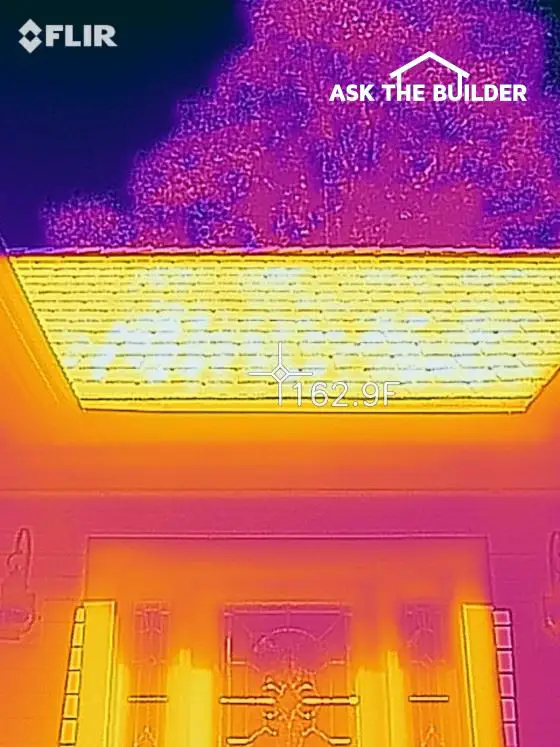
This is my own roof on an August day at noon. 162.9F !!!!! No wonder your attic space is 150F or more! Copyright 2018 Tim Carter
Question #1: Tim, can you cut through the fog of confusion about solar attic fans? I just want the tough-love truth. Do they really work or are they mostly hype? What does it take to really cool an attic space? My husband really thinks it’s a great idea to buy a solar attic fan, but I don’t want to waste the money if it does little or nothing. Bridgett W., Tampa, FL
You may have the same problem as Bridgett. There are talented and clever salespeople and marketing managers that can cast a spell upon you about new or newer products. Any product that has to do with solar or is touted as environmentally friendly breaks down the purchase barrier with little effort. After all, who doesn’t want free energy or who wants to be an environment hater?
I remember when the solar attic fan craze was hotter than the surface of my roof at noon on a summer’s day. Fan manufacturers sent me ones to test and test I did! The results were just as I expected. The solar attic fans all moved less than 1,000 cubic feet of air per minute (CFM) and they did nothing to lower the temperature inside my own attic.
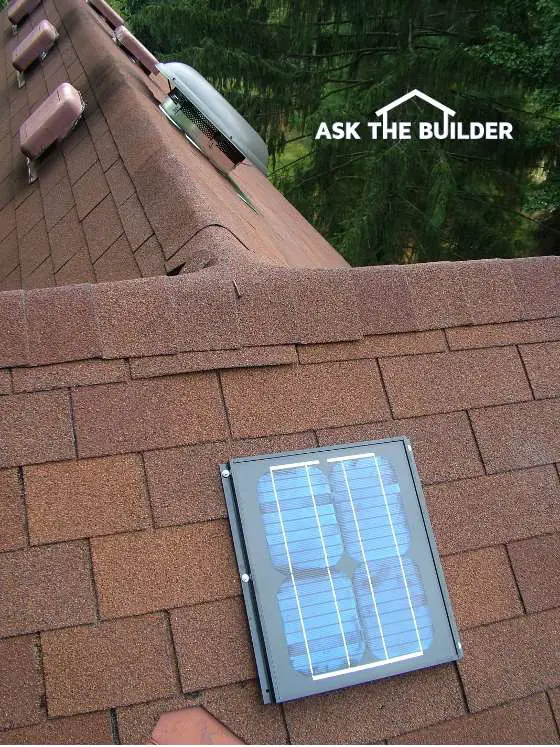
This is a solar panel supplying free electricity to the attic fan under the silver dome on the rear roof. The fan blades spin, but they don't lower the attic temperature at all. Copyright 2018 Tim Carter
The infrared rays from the sun are powerful. They can elevate your roof temperature above 160 F. I’m quite sure in certain situations I could get a reading higher than 180 F using my thermal imaging camera.
This heat is transferred to the roof sheathing and then to the roof framing members. In essence, your entire roof structure starts emitting low-level infrared heat just like the embers in a campfire.
For the attic fans to work at peak efficiency, they need to be on a south-facing roof slope if you live in the Northern Hemisphere. If a cloud blocks the sunlight, the fans slow or stop. As the sun gets lower in the sky when attic temperatures are at their greatest, the fans slow down. You need the fans to be operating at full speed late in the day and into the evening to bring air into the attic to cool all the lumber as rapidly as possible.
I tested a solar attic fan that moved 800 CFM of air. I took temperature readings in my attic as the fan operated on a cloudless day and the readings never dropped even though the fan was moving at top speed.
If you want to lower the temperature in your attic a considerable amount, you need to do what chicken farmers do. They move tens of thousands of CFM through the barns where the chickens are living. Some of the high-speed fans have blades larger than 4-feet in diameter!
This topic was first mentioned way back in my July 20, 2009 AsktheBuilder Newsletter.
I’ve got lots of extra solar attic fan data and videos on my website waiting for you. Just go to: Solar Powered Attic Fan

Most of the pipes you see in this photo are plumbing vent pipes believe it or not! (C) Copyright 2018 Tim Carter
Question #2: My new home is under construction and I stopped by to check on the progress. The plumber had just finished putting in all the drain pipes. I was surprised to see lots of pipe rising up through the walls and up in the attic. I was upset thinking that my money was being wasted but the builder said the pipes are vent pipes. I had no idea so much piping is behind the plaster in my current home and up in my attic. Are the vent pipes necessary? What do they do? Ted B., Tewksbury, MA
I’ve been a master plumber since age 29 and I can remember seeing the maze of vent pipes in a home for the first time. I had never bothered to think about what that stubby little pipe was connected to that stuck up through the roof of my parents’ home.
Vent pipes supply air into your plumbing system. Each time water drains through the pipes on its way to the sewer or septic tank it pushes air out of the way in the drain pipes. This air needs to be replaced and the best way is to grab it from the atmosphere above your home.
If you didn’t have vent pipes in your home, the water would drain sluggishly and air would get sucked into the system through other fixtures in your home. The water movement from a flushed toilet creates a significant short-lived vacuum in the system that can slurp the water from a vanity or tub trap with no effort. You may have heard this sucking noise in the past and not realized what was happening.
If a trap gets sucked dry, then sewer gas and vermin can enter your home. This is why plumbing vent pipes are so very important.
The plumbing codes in certain places allow mechanical vents at or under certain fixtures so plumbers don’t have to install all the vent pipes. I’m not a fan of these shortcut devices because they have moving parts. Anything with a moving part fails at some point. I routinely get email from people with sewer gas odor in their homes from failed mechanical vents.
There’s no substitute for a traditional vent-pipe system that has at least one full-sized vent pipe. There are no moving parts. I’m just a few months away from installing this old-fashioned time-tested system in my daughter’s new home.
I’ve got great detailed tips and remarkable vent-pipe video I shot showing you all the vent pipes in a new home. Go to: Plumbing Vent Piping Tips
Column 1261
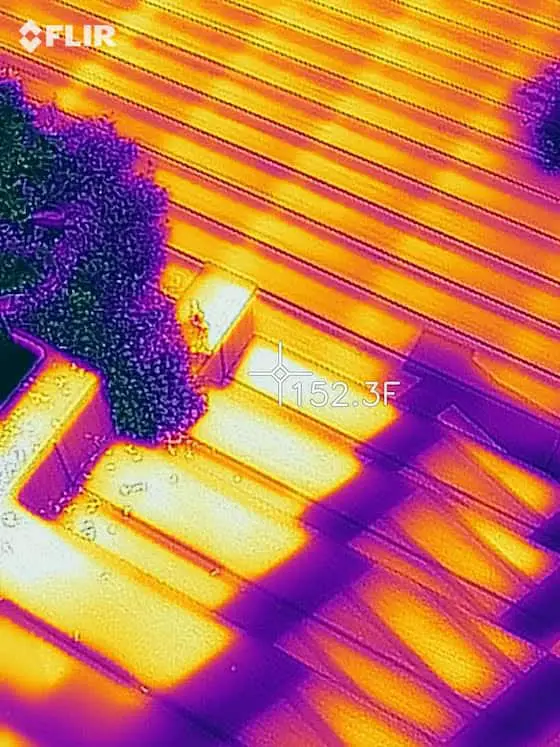
Look at the bottom step of the Trex Transcend decking. It's 152.3 F! That's hot enough to cause burns to bare skin in just seconds. (This important column was featured in the August 1, 2021 Newsletter.) Copyright 2018 Tim Carter
"I think the decking can get to over 160 F, or more, the closer you are to the summer solstice. "
The temperature of composite decking is hotter than you'd ever imagine. I tested my own Trex Transcend composite decking.
Free & Fast Bids
CLICK HERE to get FREE & FAST BIDS from local deck contractors.
The temperature of my composite decking was 152.3 F. I measured it just after noon on August 10, 2018 using a FLIR thermal imaging camera attached to my smartphone. It was a cloudless day and the sunlight had been striking the decking for hours.
I think the decking can get to over 160 F, or more, the closer you are to the summer solstice. The summer solstice is always on or about June 21st of each year. This is when the sun is highest in the sky and goes through the least amount of atmosphere.
Yes, wood can get as hot. I measured a piece of 3/4-inch oak decking and it was the exact same temperature as the composite decking, 152.3 F!
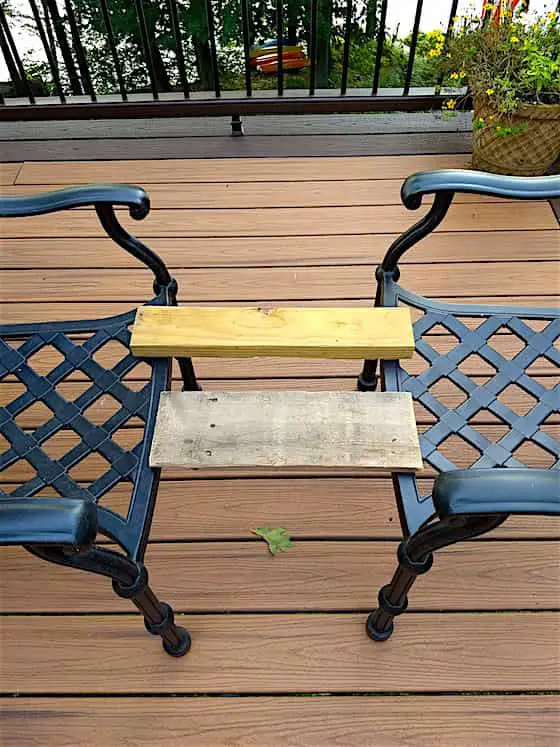
The wider piece of wood is solid oak 3/4-inch thick. The narrow board is a treated lumber 2x4. They are suspended in the air to ensure the test is accurate because the composite decking below is exposed to air beneath the deck. Setting the pieces of wood directly on the composite decking would yield inaccurate results. Copyright 2018 Tim Carter
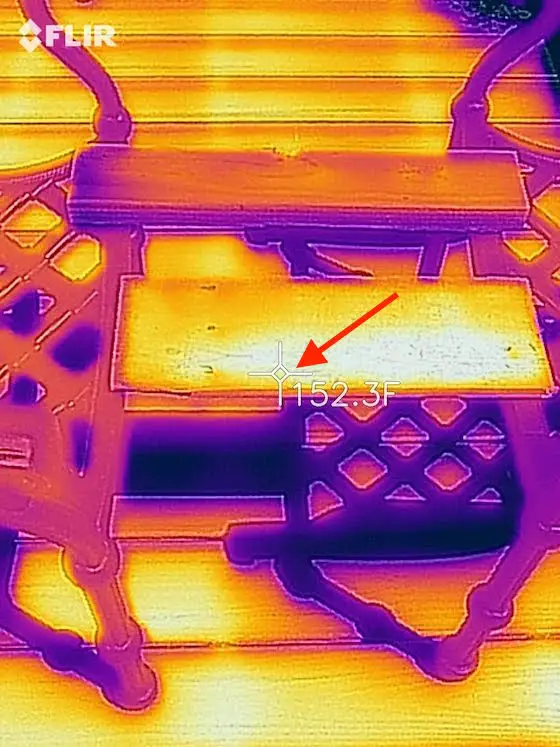
The crosshairs of the FLIR camera are on the oak as you can see. Note the temperature. I would have bet money it would have been cooler. Copyright 2018 Tim Carter
The temperature of the treated lumber 2x4 was 138.2 F. That's just 14 degrees cooler than the composite decking.
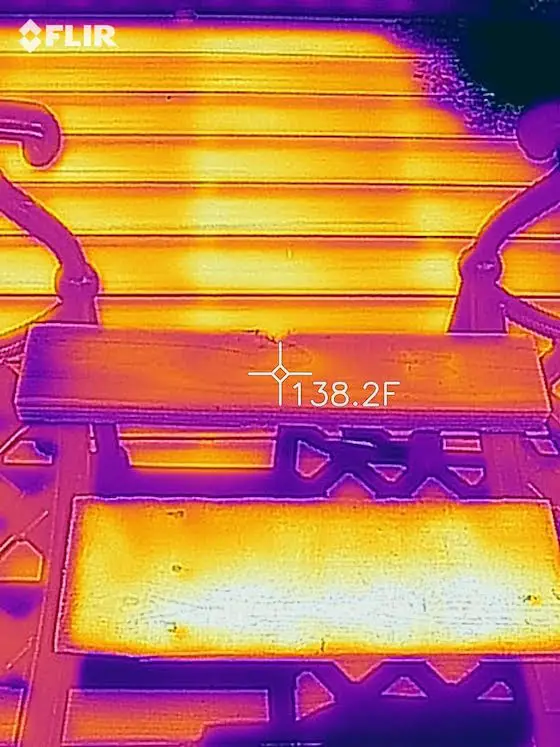
You can see the FLIR crosshairs squarely on the middle of the treated lumber 2x4. It had been in the direct sunlight for hours. The temperature is 138.2 F. Copyright 2018, Tim Carter
CLICK HERE to get FREE & FAST BIDS from local deck contractors.
Howdy stranger. Are you new around these parts? Welcome! Don't pay any attention to the locals who might tell tall tales about me and some of my exploits outside of the realm of home improvement. 😉
Two days ago, I received the most unusual phone call from Bridgett. She's an interior designer from southern California. She was in the center of a giant swirling vortex of mayhem in Houston, Texas.
Even though she's not a builder, she volunteered to take on a remodeling and reconstruction project for some big design magazine that's published on the Left Coast. The topic of the article in the magazine was rebuilding a home after Hurricane Harvey.
Her deadline was just weeks away and the project was far behind schedule. She was asking me to drop what I was doing and come down to work for free to help her out.
I'm serious, that was her request. She did say she'd fly me there and pay for housing and grub.
Early in the conversation, she mentioned the biggest problem is how the entire labor force down there has been sucked into the vortex.
"All the great contractors who are honest and know what they're doing have a two-year backlog of work," she bemoaned. "Everyone that shows up to work I have to fire within hours because they're losers," she went on to complain.
How she thought I'd be able to conjure up great subs who have NO LOYALTY TO ME is beyond comprehension.
What's the message here for you? I've shared this with you at least two other times in the past right here in the newsletter.
If a natural disaster strikes you and your family, you're going to be on your own unless you've built up a very special relationship with a general contractor. You might be lucky and be on her/his short list of preferred customers.
If you don't have a relationship, you're doomed.
You need to discover NOW, on your own, how to at least make your home livable for such time as the great contractors in your town or city get caught up. You might even stockpile emergency materials to help make the most critical repairs. That's the tough love truth.
As you might imagine, I declined Bridgett's proposal. I actually think she thought I'd come down with all my tools and do the work myself.
| CLICK HERE to get FREE & FAST BIDS from local contractors for ANY JOB. |
Get ready to fill your brains with lots of amazing candy that's going to save you lots of sweet moola and time.
I URGE you to at least open one or two of these because they all contain other amazing photos than what you see below. You'll also discover some fantastic VIDEOS.
You may not have the time right now to consume the content, but what you see may IMPRINT on your brain so you remember I have the solution to your problem when it does happen.
That's enough for a Friday.
Today is glorious weather up here in central NH. I'll be doing yard work.
This weekend, I'll be working in my garage again purging CRAP.
You might consider doing the same. It's a great feeling, believe me.
Tim Carter
Founder - www.AsktheBuilder.com
Magic Powder Man - www.StainSolver.com
Brain-Altering Wave Man - www.W3ATB.com
Do It Right, Not Over!
Welcome if you're a new subscriber! Don't let any of the seasoned subscribers tell you to wear the funny hat all day. That's bunkum and balderdash.
Do you have issues with odors at your home? Cats are notorious for marking. My own Lady the Dog used to stink up her favorite lounge chair with the oils from her fur. I miss that smell...
Just a few days ago one of our Stain Solver customers sent this email to us:
Hello Tim and everyone!
We have a cat that decided to pee on our uncoated grout & tile in the bathroom. We attempted to remove the smell with various products and cures -- we were partly successful but not completely. Then the same cat did the same thing again! So a fresh batch! What to do?
First, I wiped up the puddle. Then I went into the utility room, mixed 2 scoops of Stain Solver into 3 cups of boiling water and poured it liberally all over the bathroom floor. Using a stiff brush and keeping the floor wet for about 3 minutes, I extracted all the water. The smell was gone!
So I can say - Stain Solver worked on the old and new - like a charm - and it cleaned all grout too!
Thank you for a great product!
Sincerely,
Mark K
Jax, Florida
Kathy, my wife, and I own Stain Solver. We created the company back in 1996. It's a cottage business we operate and not only does Stain Solver get rid of odors, but it's also a powerful color and fabric-safe cleaner.
It's Certified Organic and both ingredients are Made in the USA.
Go to the Stain Solver home page and look at my most favorite Before/After photo of all time. It's a baseball cap. If that doesn't prove to you how well it works, NOTHING WILL.
Do you know what this odd shaped thing is?
CLICK HERE to discover how this metallic sausage can save you HUNDREDS of dollars.
I'm a master plumber so you can trust me on this. It's not some hokum. It's a part of building science that's rapidly becoming myth.
I know this sounds nuts, but I've decided to get back into cursive writing. I've not really done it for 45 years, and boy do you lose that muscle memory in your hands and fingers!
I wrote two cursive letters last week and they were a mess. I was taught cursive writing by the great nuns at Annunciation grade school using the giant round pencils you leaned on your shoulders. We also used the lined paper that had wood chips in it. Did you have the same experience?
BTW, within a generation, cursive writing will end up being a secret code since I believe it's no longer taught in schools. What a darn shame. That said, how in the world are they teaching kids how to sign their names????
Because of my renewed interest in cursive writing, I was quick to notice a press release not too long ago. I get press releases all the time about all sorts of products and a little over a week ago Jennifer Astin sent me one about these:


These are Little Notes by E. Frances. They're about the size of a normal business card and are designed to allow you to deliver small doses of happiness into the lives of those you love. Here are just a few places you can hide one:
E. Frances makes 35 different designs!!! I pretty much guarantee you'll find one that puts a smile on your face.
They're nice heavy card stock, the colors are vibrant and they come in a clear plastic case to protect them from dirt and dust.
CLICK HERE to see them and to order some. I get nothing if you buy some other than the notion that I helped pay forward some happiness in the life of the person who will receive your Little Note surprise!
Now that we're talking about colorful things, how about a FREE eBook that will help you choose the best colors for the outside of your home?
This is a fantastic eBook authored by Kate Smith, CMG, ICS. Those are fancy acronyms for "she knows a thing or two or three about color".
CLICK HERE to download the FREE eBook. This book was made possible for you by the fine folks at DaVinci Roofscapes. CLICK HERE for more color inspiration from DaVinci.
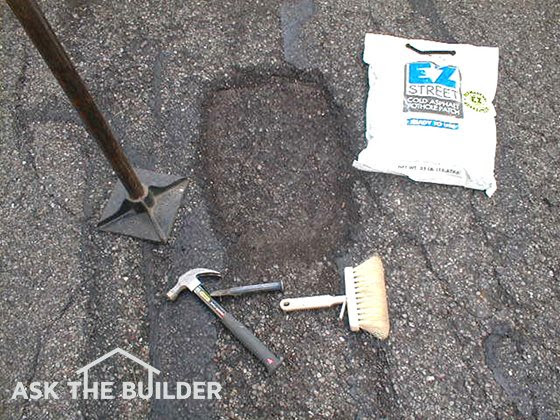
That's enough for a Tuesday wouldn't you say?
Oh, Podcast 18 is ready for you!!!! CLICK HERE to listen to it.
It's about Settlement Cracks - It's a SHORT podcast. Tell me if you LIKE the shorter format. CLICK HERE to listen.
Tim Carter
Founder - www.AsktheBuilder.com
King of Odor Removal - www.StainSolver.com
Magic in the Air - www.W3ATB.com
Do It Right, Not Over!
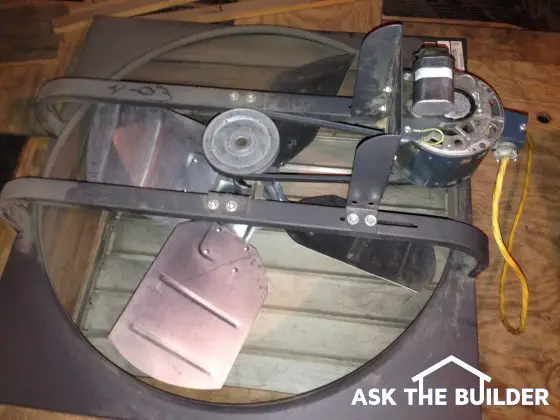
This is a whole house fan. They move vast amounts of air through a house and attic. (C) Copyright 2018 Tim Carter
Question #1: Tim, what can you tell me about whole house fans and attic fans? Do they really work to cool an attic space? I’m not sure which one I should consider one since I have air conditioning. What’s required to allow them to work at peak efficiency? Robert T., Rockdale, IL
I can share lots of advice about whole house and attic fans. I’ve installed quite a few of each one and witnessed how effective they can be. Whole house fans can be found inside a home usually in a second-floor ceiling.
A whole house fan is designed to pull air in through open windows and doors and exhaust this air through an attic space to the great outdoors. Some can move almost 300,000 cubic feet of air per hour (CFH) through your home.
The fans can move so much air that if you have the windows open in just one room, it will blow papers off of tables. You can imagine how that would cool you down with that much air blowing across your body. If you’re running an air conditioner, you wouldn’t want to have a whole house fan blowing that cooled air into your attic.
These fans were the cooling method of choice before modern air conditioning became widespread and affordable. They work well in climates that have lower humidity levels as the nighttime temperature can drop enough that you’d need a blanket on you to sleep!
Attic fans are quite different. They’re installed up on a roof or through an exterior wall up in an attic. A normal-sized one might only move 72,000 CFH of air through an attic. You can get ones that move up to 360,000 CFH of air, but these are usually designed to be wall-mounted.
The attic fans just pull air through a hot attic space in an effort to reduce the infrared heat gain you feel through the ceiling of your home. If you want your home air conditioner to cool you better, then you might want one or two attic fans.
The moving air tries to cool down all the wood attic framing as without the fan the temperature of the entire roof assembly and attic lumber can soar to 160F or more. Think of your entire roof assembly as a giant glowing ember trying to fry you like a marshmallow over a campfire.
For both fans to work well, they need large amounts of exhaust openings in the roof for the moving air to exit. Whole house fans need windows and doors open and attic fans need lots of soffit vents to suck cooler outdoor air up into the hot attic. Without this open space, the fans will not move much air. It’s easy to install waterproof gable end vents or pot vents in the roof for the air to pass back outside.
I’ve got lots of extra fence whole house and attic fan tips and videos at my website waiting for you. Just go to: Whole House Fans & Attic Fans
Question #2: Mr. Tim, can you share some fast advice about patching blacktop? Does the cold blacktop in bags really work? I’ve got time and energy but not lots of money. Susie P., Riverside, CA
You may be in the same spot as Susie. The good news is the blacktop patching material sold in bags and buckets really does work. It doesn’t produce the same satin-smooth surface as hot patch asphalt because the cold material usually doesn’t have much sand in it.
If you want success using the blacktop sold at home centers and hardware stores, first start by reading the label instructions. Too many people skip this important step.
I’ve achieved the best results by using a cold chisel and a 4-pound hammer to chisel the edges of the potholes I fill. I want the edges of the patch to be at least 1 inch deep and I do my best to tilt the chisel so the bottom of the hole is wider than the top. This is how dentists keep a filling in your tooth.
It’s very important to remove loose material at the bottom of the pothole. If you have crushed stone with fine particles, add some to the hole and compact it well. Blow all dust out of the hole and brush the edges of the hole so the asphalt will stick well to the sides of the existing blacktop.
I’ve got great detailed step-by-step tips and remarkable videos showing you secret tips for patching blacktop at my website. Go to: Asphalt Patching
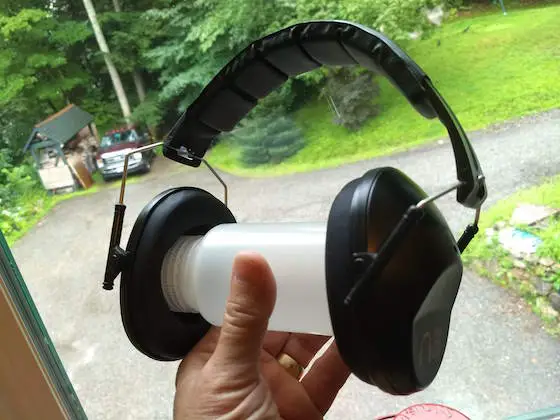
I didn't have a spare head in my man cave to put between the muffs so I substituted a small water bottle. You get the idea. Copyright 2018 Tim Carter CLICK THE PHOTO to have a pair delivered to your home.
The Pro for Sho ear muffs are quite interesting to me because of how compact they are. Each earmuff folds up under the over-the-head strap that connects them.
That's the first thing I noticed when I removed them from the box.
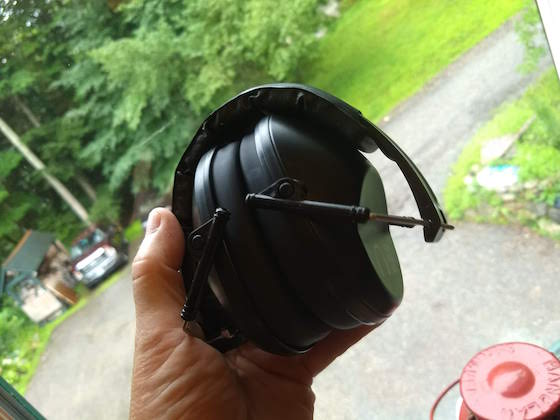
Note how they nest inside the u-shaped padded head connector gizmo. CLICK THE PHOTO now to have these in your hands in two days.
Yes, the Pro for Sho earmuffs will protect you from the noise made from guns and rifles. They offer no protection for incoming projectiles. You need Kevlar for that.

You can see they fit your head if you shoot guns and rifles. CLICK THE PHOTO to have a pair delivered to your home.
Yes, you can slide the muffs up and down to fit where your ears are on your skull.
Yes, there are quite a few colors available. CLICK HERE to see all the colors.
At the time of this review, the Pro for Sho earmuffs were less than $20 on Amazon.com. CLICK HERE to ORDER.

The STIHL AK30 lithium-ion battery. It's got much more power than version #1, the AK20. Copyright 2018 Tim Carter
The STIHL AK30 lithium-ion battery pack is loaded with power. Lots of it.
It's 36 volts and has a 4.8 aH rating. That's fancy talk for your tool will run a much longer time.
The first version of this battery was the AK20. This was the battery used when STIHL introduced their line of cordless trimmers, chainsaws, blowers, and hedge trimmers.
Look at how the AK30 will deliver more work on a single charge:
| AK20 | AK30 | |
| Weight | 2.7 lbs. | 2.9 lbs. |
| Battery Power | 100 Wh | 187 Wh |
| Rated Voltage | 36 volts | 36 volts |
| Amp Hours | 2.8 Ah | 4.8 Ah |

Here are the specs for the STIHL AK30. It's a sticker right on the battery. Copyright 2018 Tim Carter
You can only buy this battery at dealers across the USA. STIHL does not sell at their website nor do they sell their products on Amazon.com.
CLICK HERE to find the closest dealer to you.
Yes, the AK30 battery case is the exact same size as the original AK20 that came with your cordless tool.
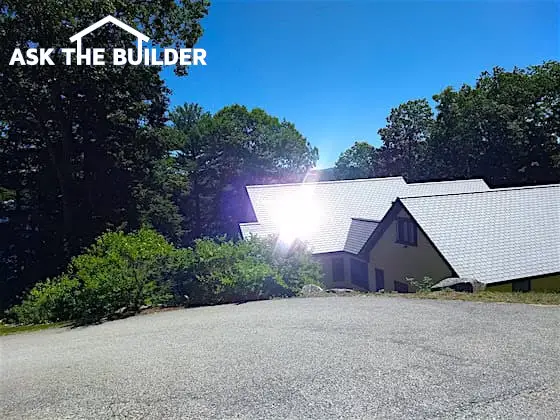
The intense heat from the skylight nearly melted my smartphone taking this photo. I had to shoot the photo fast and move. Copyright 2018 Tim Carter
It's possible for a skylight melting siding story to be in your local paper or here online. I know it's possible because I've felt the searing heat on my own face from sunlight that's concentrated and reflected by the slightly concave glass on my own skylight. I was walking up to my mailbox and thought someone was aiming a blowtorch at my face.
Related Link
Actual Melted Vinyl Siding - Podcast 6
A skylight melts siding because the glass is not flat. Gravity tugs at the center of the glass making the center lower than the sides. This concave surface concentrates the rays of the sun much like a magnifying glass does when used to ignite a fire.
No, many skylights aim the heat ray back up to the sky. It's important to realize that the sun moves during the day and through the seasons. The skylight may only aim intense heat rays at the siding or something else for a few days, or weeks, a year.
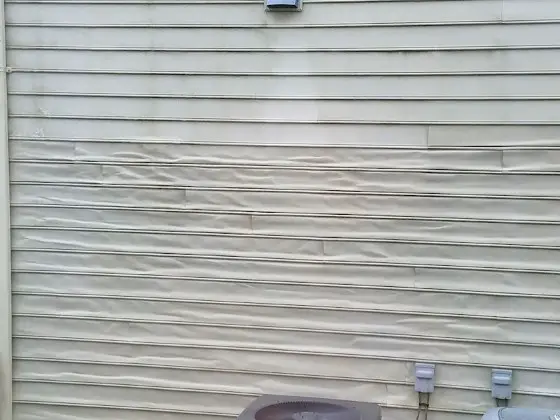
Here's a close-up shot of the melted and warped vinyl siding. This damage was caused by sunlight reflecting off a window, not a skylight. But a skylight can cause identical damage. Copyright 2018 Tim Carter
I wasn't able to measure the temperature on my face as I walked up my driveway to go to the mailbox, but I can tell you it was as hot as the heat that comes out of an open oven when you take out a pizza. It was so hot that I felt if I didn't move, my face would start to blister in seconds.

This photo was taken just moving one foot farther up the driveway. The heat rays are extremely concentrated and I estimate where I was standing they were about 9 inches in diameter as I felt no heat on my neck. Copyright 2018 Tim Carter
You can put an insect screen over the skylight to break up the sun's rays and to scatter them when they try to concentrate. It may not completely solve the problem, but it will lessen it for sure.
Subscribe to the FREE Ask the Builder newsletter to receive professional advice for your home. Complete the form below and each week you'll get:
Unsubscribe at any time. We respect your email privacy.